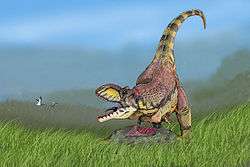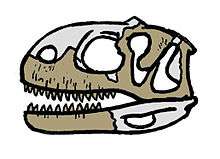Rajasaurus
| Rajasaurus narmadensis Temporal range: Late Cretaceous, 69 Ma | |
|---|---|
 | |
| Restoration of Rajasaurus with prey | |
| Scientific classification | |
| Kingdom: | Animalia |
| Phylum: | Chordata |
| Class: | Reptilia |
| Clade: | Dinosauria |
| Order: | Saurischia |
| Suborder: | Theropoda |
| Family: | †Abelisauridae |
| Subfamily: | †Majungasaurinae |
| Genus: | †Rajasaurus Wilson et al., 2003 |
| Species: | †R. narmadensis |
| Binomial name | |
| Rajasaurus narmadensis Wilson et al., 2003 | |
Rajasaurus ('Raja' meaning "king" (derived from Sanskrit) here,"king of lizards") is a genus of carnivorous abelisaurian theropod dinosaur with an unusual head crest. Between 1982 and 1984, its fossilized bones were discovered by Suresh Srivastava of the Geological Survey of India (GSI). Excavated from the Narmada River valley in Rahioli in the Kheda district of Gujarat, India, the find was announced as a new genus of dinosaur by American and Indian scientists on August 13, 2003.[1]
Paleontologists Paul Sereno of the University of Chicago, Jeff Wilson of the University of Michigan, and Srivastava worked together as an Indo–American group to study the Narmada River fossils.[2] The fossils represented the partial skeleton of the new species Rajasaurus narmadensis, which means "princely lizard from the Narmada Valley."[3] The fossilized bones of Rajasaurus have also been found in the upriver region of the Narmada, at Jabalpur, in the state of Madhya Pradesh.[2]
Description

Rajasaurus was an abelisaurid, a member of a group of theropod predators known to have lived only on landmasses that were part of the supercontinent Gondwana, such as Africa, India, Madagascar, and South America. Rajasaurus closely resembles Majungasaurus, a contemporary abelisaur from Madagascar, an island that had separated from the Indian landmass about 20 million years earlier.[4] It was found to be an abelisaurid through a phylogenetic analysis of anatomical characteristics, and was described as a carnotaurine abelisaurid (the subfamily including Carnotaurus) because of the configuration of its nasal bones and its possession of a growth ("excrescence") on its frontal bone. Rajasaurus is distinguished from other genera by its single nasal-frontal horn, the elongated proportions of its supratemporal fenestrae (holes in the upper rear of the skull), and the form of the ilia (principle bones of the hip) which feature a transverse ridge separating the brevis shelf from the hip joint.[3]
Rajasaurus was identified from a partial skeleton including a part of the skull (braincase), backbone, hip bones, parts of the hind legs and tail. This specimen, GSI 21141/1–33, serves as the type specimen of the genus and species.[3] Rajasaurus measured about 6.6 metres (22 ft) in length,[5] and what is preserved of the skull shows it bore a distinctive low rounded horn,[6] made up of outgrowths from the nasal and frontal bones.[3]
History of discovery
The Narmada River in central India drains its valley from east to west, in a rift valley and eventually into the Arabian Sea after traveling 1,312 km (815.2 mi). Dinosaur bones have been reported from the Narmada valley since the late 19th century, including some belonging to Titanosaurus indicus.[7]
The history of the fossils named Rajasaurus begins in 1981. When G.N. Dwivedi and D.M. Mohabey, geologists of the Geological Survey of India, were on a mapping mission, the workers of the ACC Cement quarry at Rahioli, in Gujarat showed them smooth ball-like limestone structures from the quarry. These "balls" turned out to be dinosaurian eggs. The geologists also found that the limestone bed containing the fossilized eggs was underlain by a layer of coarse sandstone and conglomerate with abundant dinosaurian fossil bones.[2]
During the years 1982–84 Suresh Srivastava, a GSI geologist at the Palaeontology Division of the GSI's Western Region, collected large numbers of bone fossil fragments from Rahioli, and also precisely mapped the area. These fossils were taken to the Palaeontology Division at Jaipur for identification. U. B. Mathur and Suresh Srivastava, under the supervision of S. C. Pant, meticulously cleaned many of the skeletal parts (braincase, dorsal and caudal vertebrae, sacrum, thigh bone, upper arm, shin bones, and others), leading to the publication of multiple research papers.[8][9] There was a lull in further activity until a Memorandum of Understanding (MOU) was signed with Punjab University in 1994–95.[2]

In 2001, further research on the fossils was continued by two American scientists sponsored by the American Institute of Indian Studies, New Delhi and the National Geographic Society, U.S.A.[2] The Americans, Paul Sereno and Jeff Wilson, started the reconstruction of the collection of dinosaur bones gathered in 1983 and 1984. The team of scientists, after a detailed study of the maps prepared earlier by Srivastava, were able to reconstruct the partial skull, left and right hip bones, and a sacrum. They interpreted the part of a skull and a horn as resembling those of dinosaurs found in Madagascar.[1] Fossils of Rajasaurus were also found near Jabalpur in Madhya Pradesh. In all, the collected fossils include a partial skull, limb bones, hip bones, and vertebrae.[10]
Although Rajasaurus was formally described in 2003, there are fossils described in 1923 that may belong to this genus. Charles Alfred Matley described Lametasaurus indicus in that year from specimens including an ilium, a sacrum, a shin bone, and armor scutes found at Bara Simla.[11] Lametasaurus was later shown to be a chimera, and Wilson et al. suggested that the ilium and sacrum (now lost) were exemplars of the similarly stout Rajasaurus.[3]
The discovery of Rajasaurus could lead to additional information on the evolutionary relationships of abelisaurs, since previously described specimens from India were mainly isolated bones.[6] At a press conference held in 2003 on the discovery of Rajasaurus, Sereno stated:
The discovery, which will be put for examination before global experts, was important since it would help in adding to the current knowledge of dinosaur belonging to the family of Abelisaur predators and adding a new angle to dinosaurs in the Indian subcontinent.[12]
Palaeobiology

Rajasaurus is known only from the Indian Peninsula. At the time it was alive, the Indian landmass had recently separated from the rest of Gondwana and was moving north. While Rajasaurus had evolved along its own direction, it was still similar to other abelisaurids such as Majungasaurus from Madagascar and Carnotaurus from South America; these animals descended from a common lineage.[2]
Rajasaurus has been found in the Lameta Formation. This rock unit represents a forested setting of rivers and lakes that formed between episodes of volcanism. The volcanic rocks are now known as the Deccan Traps. Rajasaur and sauropod fossils are known from river and lake deposits that were quickly buried by Deccan volcanic flows.[2] Other dinosaurs from the Lameta Formation include the noasaurid Laevisuchus, abelisaurids Indosaurus and Indosuchus, and the titanosaurian sauropods Jainosaurus, Titanosaurus,[13] and Isisaurus.[14]
Coprolites have been recorded in the Lameta Formation, and the presence of fungi in coprolites indicates that leaves were eaten by the dinosaurs which lived in a tropical or subtropical climate.[15] Another scientific study of similarities in egg taxa suggested close phyletic relationships that supports the existence of a terrestrial connection between dinosaurian fauna in India and Europe during the Cretaceous, and between two Gondwanan areas, Patagonia and India.[16]
Cultural significance
In order to educate people about extinct forms of life, the Geological Survey of India installed life–size fibreglass models of Rajasaurus and Titanosaurus at their Lucknow regional office.[17] The installation is presented in an appropriate setting, with representations of plants that existed during the Mesozoic Era. Also displayed are limb bones, vertebra, eggs and coprolites of sauropod dinosaurs and fossil eggs of Rajasaurus collected from Gujarat and Madhya Pradesh.[17][18]
A restored skull of Rajasaurus is a prominent exhibit in the Indian Museum at Kolkata.[17]
Also interested in Rajasaurus is Aliya Babi (of the erstwhile royal family of Balasinore), who became a dinosaur enthusiast after closely watching the efforts made by GSI at Rahioli to unearth the fossils, and made efforts to promote dinosaur tourism to Rahioli in order to showcase its millions of years of dinosaur heritage. She also set up a small museum at her hotel.[19]
A Jurassic Ride Rajasaurus River Adventure[20] has been launched at the Adlabs Imagica, India. The ride is inspired by Jurassic Park: The Ride located at Universal Parks.
See also
References
- 1 2 Lovgren, S. (August 13, 2003). "New Dinosaur Species Found in India, page 1 of 2". National Geographic News. Retrieved 2009-04-12.
- 1 2 3 4 5 6 7 "Rajasaurus narmadensis – India's own dinosaur emerges from oblivion" (PDF). Geological Survey of India. Archived from the original (PDF) on May 28, 2008. Retrieved 2009-04-08.
- 1 2 3 4 5 Wilson, J.A., Sereno, P.C., Srivastava, S., Bhatt, D.K., Khosla, A. and Sahni, A. (2003). "A new abelisaurid (Dinosauria, Theropoda) from the Lameta Formation (Cretaceous, Maastrichtian) of India." (PDF) Contributions from the Museum of Paleontology University of Michigan, 31(1): 1-42.
- ↑ Rogers, Raymond R.; Krause, David W.; Curry Rogers, Kristina; Rasoamiaramanana, Armand H.; & Rahantarisoa, Lydia. (2007). "Paleoenvironment and Paleoecology of Majungasaurus crenatissimus (Theropoda: Abelisauridae) from the Late Cretaceous of Madagascar". In Sampson, Scott D.; Krause, David W. Majungasaurus crenatissimus (Theropoda: Abelisauridae) from the Late Cretaceous of Madagascar. Society of Vertebrate Paleontology Memoir 8. pp. 21–31. Cite uses deprecated parameter
|coauthors=(help) - ↑ Grillo, O. N.; Delcourt, R. (2016). "Allometry and body length of abelisauroid theropods: Pycnonemosaurus nevesi is the new king". Cretaceous Research. doi:10.1016/j.cretres.2016.09.001.
- 1 2 Lovgren, S. (August 13, 2003). "New Dinosaur Species Found in India, page 2 of 2". National Geographic News. Retrieved 2009-04-08.
- ↑ Lydekker, R. (1877). "Notices of new and other Vertebrata from Indian Tertiary and Secondary rocks." Records of the Geological Survey of India, 10(1): 30-43.
- ↑ Mathur,U. B. and Pant S. C. (1986). "Sauropod dinosaur humeri from Lameta Group (Upper Cretaceous-?Palaeocene) of Kheda Group, Gujarat" Journal of the Palaeontological Society of India, 31: 22-25
- ↑ Mathur,U. B. and Srivastava S.(1987). "Dinosaur teeth from Lameta group (Upper Cretaceous) of Kheda district,Gujarat" Journal of the Geological Society of India, 29: 554-566
- ↑ "The first Indian dinosaur emerges from oblivion". Geological Survey of India. Archived from the original on November 7, 2007. Retrieved 2009-04-08.
- ↑ Matley, C.A. (1923). "Note on an armored dinosaur from the Lameta beds of Jubbulpore". Records of the Geological Survey of India. 55: 105–109.
- ↑ "Move over T-Rex, Rajasaurus narmadensis is here". Rediff.com. 2003-08-13. Retrieved 2009-04-09.
- ↑ Weishampel, David B.; Paul M. Barrett, Rodolfo Coria, A., Jean Le Loeuff, Zhao Xijin Xu Xing, Ashok Sahni, Elizabeth M.P. Gomani and Christopher R. Noto (2004). "Dinosaur Distribution". In David B. Weishampel; Peter Dodson; Halszka Osmólska. The Dinosauria (2nd ed.). Berkeley: University of California Press. p. 595. ISBN 0-520-24209-2. Cite uses deprecated parameter
|coauthors=(help) - ↑ Upchurch, Paul; Barrett, Paul M.; Dodson, Peter. (2004). "Sauropoda". In Weishampel, David B.; Dodson, Peter; Osmólska, Halszka. The Dinosauria (2nd ed.). Berkeley: University of California Press. p. 270. ISBN 0-520-24209-2.
- ↑ Sharma, N., Kar, R.K., Agarwal, A. and Kar, R. (2005). "Fungi in dinosaurian (Isisaurus) coprolites from the Lameta Formation (Maastrichtian) and its reflection on food habit and environment." Micropaleontology, 51(1): 73-82.
- ↑ Vianey-Liaud, Monique; Khosla, Ashu; Garcia, Geraldine. "Relationships between European and Indian Dinosaur Eggs and Eggshells of the Oofamily Megaloolithidae". Bioone.org. Retrieved 2009-04-09.
- 1 2 3 "Life-size fibre glass models of Indian dinosaurs, Rajasaurus and Titanosaurus inaugurated at GSI" (pdf). Geological Survey of India, Northern Region, Lucknow. 2007-07-18. Retrieved 2010-11-10.
- ↑ "Tender for fabricating fibre glass life size models of dinosaurs" (PDF). Geological Survey of India. Retrieved 2009-04-12.
- ↑ "A Princess and her Rajasaurus". Times of India. 2008-12-21. Retrieved 2009-04-09.
- ↑ "Rajasaurus River Adventure". Park Adlabs Imagiaca. 2013-04-18. Retrieved 2013-11-23.
External links
| Wikimedia Commons has media related to Rajasaurus. |
- Rajasaurus on NationalGeographic.com
- Rajasaurus narmadensis
- "Rajasaurus stalked the banks of Narmada" The Hindu, 2003